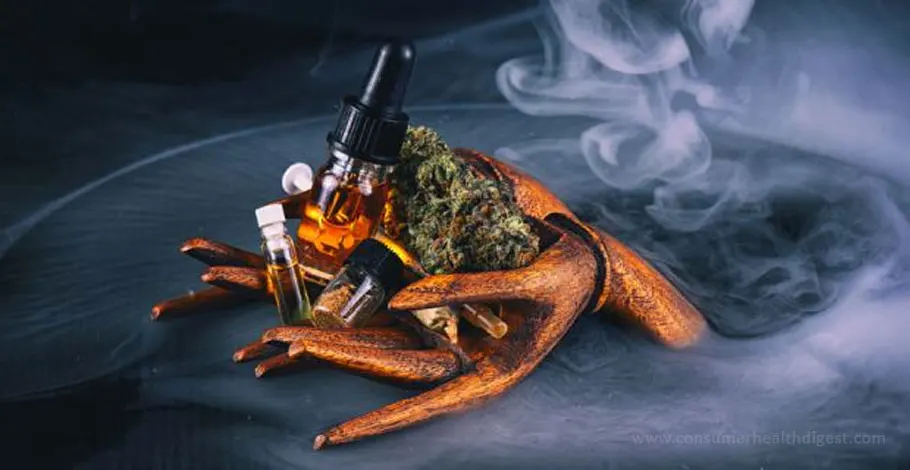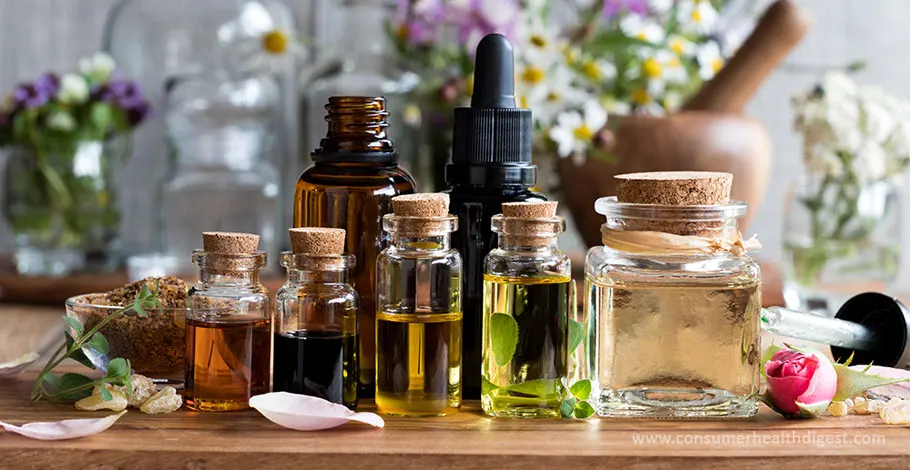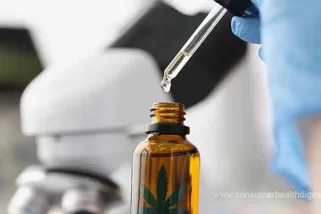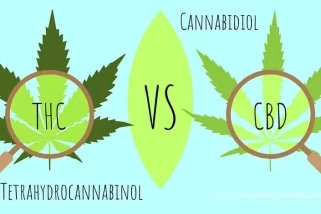In This Article
Have you ever wondered why there’s a distinct aroma in some herbs, fruits, and leaves? The aromatic factors are controlled by terpenes. It is a natural and organic compound which is found in plants and possesses enormous potential in health management.

Today we are going to learn about terpenes, where you can find it and their roles and how association with cannabis.
What Is Terpenes?
Terpene[1] is an organic hydrocarbon compound which is volatile in nature. It is produced in the epidermal cells i.e. glandular trichomes[2], in the plants. It is found in the essential oils and is known to possess an aroma.
Though the humans have always been crazy for the natural aroma extraction from the ancient times, the basic responsibility of the terpenes is to protect the plants from insects, herbivores, bacteria, and fungi.
There are hundreds of different types of terpenes, and cannabis alone is a rich source of nearly 200 terpenes. Some terpenes have strong smelling properties, while some are mild and pleasant to our sensory organs.
Plant-based organic essential oils extracted from the leaves, flowers, fruits, barks, and seeds contain terpenes. Synthetic terpenes are produced in the labs under controlled atmosphere.
Terpenes easily evaporate and are susceptible to heat. During the daytime, the terpenes evaporate from the tiny glandular trichomes. That is why you can smell the trees and flowers in summer or in the morning from a distance.
The conifers are particularly considered to be among the rich sources of terpenes. Although these are mainly plant-derived products, some insects and butterflies are known to produce terpenes.
There is a widely accepted myth that terpenes and terpenoids are the same. On the contrary to popular belief, terpenes are isoprenes (hydrocarbons) which are made of hydrogen and carbons, whereas, terpenoids are the produce of oxidization.
Extraction of essential oil or terpenes in the lab is done by applying several methods, but the basic procedure is by boiling and distillation of the plant substances.
Extracted terpenes are used for medicinal properties in cosmetics, drugs, and toiletries. It also has healing properties, for which it is widely used in terpene aromatherapy.
Where Do You Get Terpenes?

All aromatic plant, barks, resins, leaves, and fruits contain volatile terpenes. The essential oils contain terpenes, however, some of the properties can be destroyed in the processing if the extraction method was faulty. If you are using fresh and organic herbs and plants, the benefits are likely to increase. Peppermint, spearmint, cedarwood, sandalwood, Eucalyptus, cinnamon, cardamom, oregano, thyme, tea tree, cannabis, citrus fruits such as oranges, lemon and lime are only a few names of the essential oil sources.
Each essential oil type is attributed to special terpene. While some common terpenes are found in multiple sources, there are other types which are limited to particular species. The fruits and herbs that are rich in terpenes are:
- Rosemary: Rosemary[3] contains a high amount of terpinolene. Rosemary essential oil has great medicinal and healing quality, it is even used for strengthening cognitive development, writes naturopathic physician Jessica Patella[4].
- Eucalyptus: Eucalyptus[5] essential oil is a rich source of various terpenes, among which Eucalyptol or cineole is prime. The use of eucalyptus essential oil is seen in naturopathy. It is anti-inflammatory and relieves pain, has antioxidant and antibacterial properties.
- Bay Leaf: Organic bay leaf has beta-myrcene and several other organic terpene compounds. It is used in edible products for aroma and health benefits. [6]
- Lavender: Rich in linalool, lavender is famous for several reasons. Starting from beauty products, toiletries, perfumes to essential oils, lavender has been in the use from ages. It has healing properties.[7]
- Thyme: Thymol, a special type of terpene is found in thyme which has excellent antibiotic properties. It is also antibacterial and prevents flu.[8]
- Vitamin A: The isoprene units present in Vitamin A are known as diterpenes. All the vegetables and fruits rich in vitamin A also have terpenes. [9]
- Mint: Mint has varieties of terpenes. It is widely popular all over the world for its health benefits and antibacterial properties. The crunchy and succulent leaves are a rich source of alpha-pinene, phellandrene, l-limonene, beta pinene, octanol, and cineol. [10]
- Citrus fruits: lemon, lime, sweet oranges and all other citrus fruits are rich in limonene. It is used in perfumes, beauty products, and aromatherapy.
- Camphor: The strong pungent odor in camphor is due to camphene, a special terpene. It has anti-fungal and antibacterial properties and widely popular in the cosmetic industry, taste enhancer in the food industry and in pesticides. [11]
- Sweet Basil: Rich in myrcene terpene, sweet basil is used for its antibiotic advantages. [12]
- Pine: Monoterpenoid pinene is abundant in pine wood and fir. There are two types of pinene found in pine, which are known as alpha-pinene and beta-pinene. It is useful for mental health and asthma patients.
Terpenes In Cannabis & Their Roles

Terpenes In Cannabis & Their Roles
Cannabis refers to the group of plants comprise of marijuana or Cannabis sativa I and hemp or Cannabis sativa L. Cannabis plants are the best sources of terpenes because it alone houses more than 120 terpenes which are rare in nature.
Essential oils extracted from cannabis are used in medical treatment and drugs, beauty products, and perfumery. Rich in organic compounds, these terpenes are most valuable and extremely beneficial for healing and prevention of diseases.
You can buy different types of essential oils but cannabis oil alone provides nearly all major terpenes. It is all in one product which has been in use since ancient times. Terpenes are found in the resins from glandular trichomes in female inflorescences in Cannabis sativa.
Terpenes are the building blocks of cannabinoids in cannabis plants. The therapeutic pharmacological benefits determine synergizing effects in cannabis terpenes which is most commonly referred to as “entourage effect”.
THC (tetrahydrocannabinol) compound in cannabis has been the center of attraction to many research scholars, geneticists, naturalists, biologists and in the field of organic chemistry, while other terpenes and cannabinoids have been overlooked.
In the more recent years, some researchers have shown interest in extraction, preservation and using the cannabis essential oil to study the effects of terpenes, flavonoids, and cannabinoids on the humans. Together all these ingredients act as a natural defense against bacterial infection, skin diseases and improve mental and internal health.
You will often find these terms when we will discuss the terpenoids in cannabis- monoprenes which are single isoprenes, sesquiterpenes are three linked isoprene units and diterpenes are four units.
Depending upon developmental, environmental and genetic factors the composition and concentrations of terpenes in cannabis vary greatly.
In some cases, one may still be able to predict the ratio of cannabinoids in different strains of cannabis but the concentration of terpenes remains unpredictable.
The major terpenes found in cannabis are linalool, limonene, myrcene, eucalyptol, caryophyllene, pinene, terpinene, guaiol, humulene, ocimene, valencene, phytol, and nerolidol.
1. Limonene
The refreshing and cool scent of citrus fruits is due to limonene. The smell instantly hits the nervous systems and almost brings us back to life after a tiring day at work. The use of limonene can be seen in a variety of products.
Studies show that the scent of limonene has proved to reduce depression among the patients in the hospitals and therefore, is used to treat anxiety and mental disorders.
D-limonene type is especially found in the oranges and has several benefits. In soaps, shower gels, shampoos, creams, body lotion, facial cleansing milk, and face wash and in the perfumes you would see that limonene has been used.
The ingredient is widely popular among the aromatherapists as well. Use of limonene in the food industry as additives and flavor enhancer is quite popular. The use of limonene to control gastroesophageal reflux is well established.
2. Beta-Myrcene
It is also most common terpene found in cannabis. The herbal aroma of beta-myrcene has hundreds of benefits. Other than cannabis, you can also find it in bay leaf, lemongrass, eucalyptus, and hops.
Some cannabis strains contain nearly 60% beta myrcene monoterpene out of the total oil extracted. Other than perfumery, it is also used in medicine, drugs, naturopathy, and aromatherapy.
It is antibiotic, analgesic, anti-inflammatory, and anti-depressant. It has calming effects on the mind and is used for relaxing the brains. It lowers the resistance power of the brain and allows the organic chemicals to react with the blood quickly. Therefore, it may also expand the absorption of THC in blood.
3. Alpha-Pinene
Pinene is abundant in the coniferous plants. It is found in pine trees and also in cannabis strains. The bicyclic monoterpenoid is made of alpha-pinene (a-pinene) and beta-pinene (ß-pinene), the first one being most commonly found in nature.
Having antibiotic properties, it helps to kill bacteria and reduces inflammation. Alpha-pinene also increases cognitive function among the patients.
Several types of research have been carried out to explain the medicinal benefits of a-pinene and it is proved that it is a natural bronchodilator which helps clear congestion and sinusitis. In order to relax the mind and to improve concentration the use of pinene is remarkable. Weiqiang Chen and colleagues published a research paper which mentions that a-pinene has anti-tumor effects.
4. Linalool
It is one of the major terpenes found in cannabis plants. The sweet lavender scents notify the presence of linalool. Other than lavender, you can also find it in cannabis. Other sources are mint, coriander leaves, basil, cinnamon and citrus fruits.
It is composed of two isomers- R-linalool and S-linalool. It has calming effects on the body and mind, and therefore, very useful in anxiety and stress management.
Researchers claim that linalool helps to relax the mind and relieves emotional stress, and is also seen effective in restoring psychological balance and in Alzheimer’s disease. Additionally, it is known for strengthening immunity and boost lung functions. Together with THC linalool stimulates the neurotransmitters and may have analgesic and sedative effect.
5. Caryophyllene
It is a sesquiterpene which is found in the combination of humulene or a-caryophyllene, ß-caryophyllene, and caryophyllene oxide. In fact, the police dogs are trained to smell this particular substance in order to nab the dealers and consumers.
Beta-caryophyllene (ß-caryophyllene) is known as dietary cannabinoid and is used to treat atherosclerosis, inflammation osteoporosis and pain. Béla Horváth and colleagues have said that beta-caryophyllene is effective to treat kidney patients and has a great potential for nephropathy.
It is found in cannabis and other spices such as black pepper, cinnamon, cloves, and basil. It is a non-psychoactive CB2 receptor which is can be consumed as diet.
6. Eucalyptol
We have already learned that eucalyptus is the main source of this eucalyptol. Eucalyptol is also found in cannabis and used in various types of drugs and aromatherapy. The medicinal benefits of being extended towards respiratory health.
In order to clear nose blockage, sinus and even snoring or sleep apnea, the use of eucalyptol can be seen.
However, the ingredient is also linked with psychotropic drugs. Therefore, please check if the cannabis oil you are purchasing does not contain more than 0.002% eucalyptol. It is also known for its anti-inflammatory effects.
Read Also – Side Effects Of Hemp Oil
7. Camphene
Camphene is found in camphor and also in cannabis. It has a pungent terpene smell and is used as a flavour enhancer in food products. It is also used in medicine and cosmetics because it has antibacterial agents.
In order to treat cardiovascular diseases, the use of camphene is well documented. It may lower cholesterol levels in the body and control triglycerides. Additionally, it can be mixed with vitamin C and used as an antioxidant to fight skin aging.
Camphene is used for its antibacterial properties to fight skin diseases and bacterial and fungal infections, psoriasis and eczema. These natural terpenes and organic compounds are essentially useful for several types of patients.
8. Terpinolene
It is found in several herbs such as rosemary, sage, and others. You can easily trace this element in perfumery and bathing bars, gels and shampoos. It has gentle and sweet aroma with a citrus flavor.
In order to boost neural health, administration of terpinolene is noteworthy. Woody and piney smell cannabis is often a good source of terpinolene. It is found to be antioxidant, and therefore, reduces and prevents the signs of aging.
Extracted terpinolene from cannabis oil has medicinal effects on health. To help a patient suffering from anxiety, depression, insomnia, and migraines, use of terpinolene are noted.
9. Phellandrene
The citrus smell of cannabis is responsible for phellandrene. Other than cannabis, it is found in peppermints and citrus fruits. Isomeric phellandrene contains cyclic monoterpenes a-phellandrene and ß-phellandrene which is found in eucalyptus oil.
The fragrant phellandrene is used in several beauty products and naturopathy. Use of phellandrene in aromatherapy is seen as tonic for the mucous membrane, to relieve nasal congestion and few others.
10. Humulene

Humulene
Regarded to be the sole reason for its ‘hoppy’ aroma, humulene is widely popular for its distinct odor. The name is derived from Humulus Lupulus or hops in which the terpene is abundant.
Most often, the term ‘humulene’ refers to a-humulene or a-caryophyllene and ß-caryophyllene. It is a sesquiterpene of three isoprenes.
The benefits of humulene have extensively studied. Research shows that it is useful to produce Reactive Oxygen Species in cells to fight cancer. It prevents inflammation on the topical and internal use and reacts against bacterial infection.
You May Also Want To Read – Side-Effects Of Mainstream Pharmaceuticals, Many Consider CBD
11. Carene
It is a monoterpene marked by Delta-3-career. You can identify it with its mildly sweet and pungent odor. It is present in cannabis essential oil and juniper, fir and cypress. It is used as an antidepressant. The sweet smell easily cheers up the mood and benefits the mental health patients greatly.
Carene is used in treatments, therapies and as flavoring agents in food products. It is non-toxic but some reaction or allergic symptoms such as sneezing, coughing, and dry mouth can appear depending upon the quality of the strains.
To control the bodily fluids, the contribution of carene is enormous. To control heavy bleeding in the periods, running nose and excessive loss of body fluids careen is proved useful.
12. Geraniol
Lemonol or geraniol is a monoterpene alcohol and is found in the flowers. It is antioxidant, antibacterial and anti-fungal. It has anti-tumor elements and is known to protect from viral cold and flu. It also stimulates the neuron receptors and increases cognitive abilities.
Like valencene, geraniol is also used to repel mosquitoes and insects. Therefore, both are used in mosquito-repellent lotions and creams.
List Of Hemp Cannabinoids And Terpenes
Unlike marijuana, hemp contains a lower concentration of terpenes. However, hemp essential oil is still rich in several important terpenes. The most common hemp terpenes are myrcene, d-limonene, linalool, alpha-pinene, humulene, eucalyptol, and nerolidol.
The use of hemp and hemp seed oil is practiced to prevent autoimmune diseases, fight skin problems, rheumatoid arthritis, anxiety, and sleeplessness.
Terpenes In Hemp
We have already learned about all major terpenes in the previous section, so let’s find out about nerolidol and phytol.
- Nerolidol: Peruviol or nerolidol is a sesquiterpene alcohol. It is naturally found in hemp and hemp seed essential oil. Other sources of nerolidol are jasmine, lemongrass, tea tree, and ginger. It prevents fungal and bacterial infection and prevents inflammation.
- Phytol: It is a diterpene which is used as food additives. Cannabis, green tea, and few other herbs are rich sources of phytol. It has great relaxing benefits on the brains and therefore, is often administered in the drugs to control anxiety and to stimulate the cognitive functions.
Hemp Cannabinoids
There are a number of cannabinoids found in hemp which are beneficial for the humankind. The major cannabinoids are:
- THC: It is the most commonly known cannabinoid. It is present in hemp trees, and the leaves, however, the seeds do not contain THC or Tetrahydrocannabinol. It has psychoactive substances, the main reason for getting ‘high’ and is considered to be illegal in most of the places.Hemp oil, hemp seed, and industrial hemp are devoid of THC elements, and that’s why permitted to use.
- CBD: Cannabidiol or CBD is another element in hemp known for its pharmaceutical benefits. It is a non-toxic ingredient that does not cause hallucinations or ‘high’. It is antidepressant, anti-psychotic, anti-inflammatory and antioxidant.
- CBN: Cannabinol is antipsychotic. Research shows that administration of cannabinol alongside THC, blocks the THC effects, meaning, it overshadows the psychological reaction of THC, and controls the pulse rate. F.F. Peres and colleagues propose the administration of CBN in schizophrenia.
- CBC: Cannabichromene is considered to be a phytocannabinoid because it is found in the hemp plants. It is a non-toxic and non-psychoactive cannabinoid. CBC is used as an anti-inflammation ingredient in acne-control products. It also promotes bone growth.
- CBDV: CBDV is an abbreviation of Cannabidivarin cannabinoid in hemp. It is non-psychoactive and used in medicine to treat neurological conditions. Scientists have also tested its use and effects in epilepsy.
- THCV: Tetrahydrocannabivarin is structure wise similar to THC. Research shows that THCV is used to help with diabetes and reduce appetite. Additionally, the benefits are also experienced in the field of mental health. Tetrahydrocannabivarin is known to help Alzheimer patients and stress.
- CBDA: Cannabidiol Acid is present in raw and unprocessed cannabis extracts found in the market or in the hemp plants. Therapeutic benefits of CBDA are utilized to prevent nausea, cancer, and mental or psychotic disorders.
- CBG: Cannabigerol is found in a limited amount. It has numerous health benefits. It helps in skin diseases, neurological diseases, inflammation and others. It is non-psychoactive.
Read More: Selecting The Best CBD Oil – An Ultimate Guide To Purchase CBD Oil
Final Verdict
From this discussion, we hope to cover the benefits of cannabinoids and terpenes in hemp, marijuana, and other plants.
We sincerely hope that you have found this helpful and now you are more confident to purchase essential oils that are useful for your treatment. Just remember to consult with your physician before use.
12 Sources
We review published medical research in respected scientific journals to arrive at our conclusions about a product or health topic. This ensures the highest standard of scientific accuracy.
[1] Cannabis and Terpenes: What Do We Really Know?: https://www.analyticalcannabis.com/articles/cannabis-and-terpenes-what-do-we-really-know-310844[2] Plant glandular trichomes: https://link.springer.com/article/10.1007/BF02837613
[3] Pérez-Sánchez A, Borrás-Linares I, Barrajón-Catalán E, Arráez-Román D, González-Álvarez I, Ibáñez E, Segura-Carretero A, Bermejo M, Micol V. Evaluation of the intestinal permeability of rosemary (Rosmarinus officinalis L.) extract polyphenols and terpenoids in Caco-2 cell monolayers. PLoS One. 2017 Feb 24;12(2):e0172063. doi: 10.1371/journal.pone.0172063. PMID: 28234919; PMCID: PMC5325326.
[4] Effects of Rosemary Essential Oil on Mood and Memory: http://www.naturalhealthresearch.org/rosemary-essential-oil/
[5] Terpene Profile: Eucalyptol: http://theleafonline.com/c/science/2014/11/terpene-profile-eucalyptol/
[6] Bay Leaf Whole, Organic: https://www.herbco.com/p-1118-bay-leaf-whole-organic.aspx
[7] Guitton Y, Nicolè F, Moja S, et al. Lavender inflorescence: a model to study regulation of terpenes synthesis. Plant Signal Behav. 2010;5(6):749-751. doi:10.4161/psb.5.6.11704
[8] Borug? O, Jianu C, Mi?c? C, Gole? I, Gruia AT, Horhat FG. Thymus vulgaris essential oil: chemical composition and antimicrobial activity. J Med Life. 2014;7 Spec No. 3(Spec Iss 3):56-60.
[9] Practice Essentials: https://emedicine.medscape.com/article/818675-overview
[10] Mint Terpenes Mint, Menthol & Isolates: https://www.kancor.com/mint-terpenes/
[11] National Center for Biotechnology Information (2023). PubChem Compound Summary for CID 2537, Camphor. Retrieved February 17, 2023 from https://pubchem.ncbi.nlm.nih.gov/compound/Camphor.
[12] Terpene Profile: Myrcene: http://theleafonline.com/c/science/2014/09/terpene-profile-myrcene/








 This article changed my life!
This article changed my life! This article was informative.
This article was informative. I have a medical question.
I have a medical question.
 This article contains incorrect information.
This article contains incorrect information. This article doesn’t have the information I’m looking for.
This article doesn’t have the information I’m looking for.